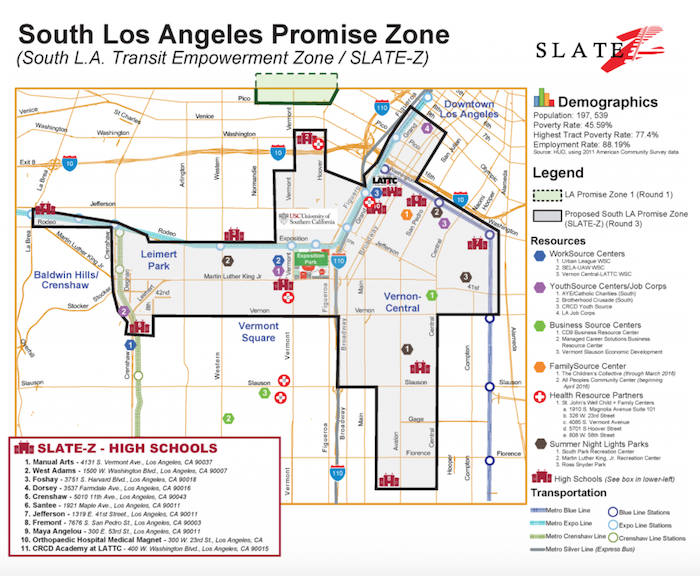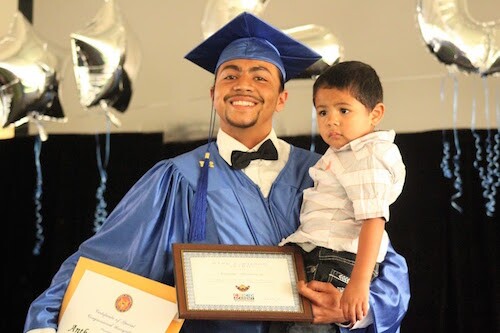South L.A. Promise Zone Keeps Feds Investing in Area

The South L.A. Transit Empowerment Zone, or Slate-Z, has been racking up victories in funding economic opportunity programs since receiving designation last year as a Promise Zone in the highly competitive federal program. Promise Zone designation lasts a decade, showing how the flow of money from Washington to communities happens quietly in the background while other issues grab more attention.
Former President Barack Obama announced the Promise Zone initiative in 2013. Promise Zones tend to be communities with high poverty rates, where the federal government works with local leaders to create jobs, improve access to affordable housing, enhance public safety and grow economic opportunities for residents. According to the U.S. Department of Housing and Urban Development, Promise Zones receive priority access to federal investments, liaisons to help with federal programs and AmeriCorps VISTA members to assist with efforts.
The Republican administration in Washington has faced strong resistance from California’s urban community leaders and Democratic officials on many issues such as immigration enforcement and environmental regulation. Meanwhile, Slate-Z has assembled a coalition of over 80 local elected officials, public agencies, schools and nonprofits to work on revitalization plans.

Promise Zone designation brings access and priority to resources and grants, but Slate-Z still has to work to bring money to the community. Slate-Z initiating director Heddy Nam says many people assume federal money comes automatically with the Promise Zone designation. Slate-Z partners still have to apply for grants. The designation gives Slate-Z partners a boost in the way federal agencies score their proposals in certain federal grant programs.
Nam who works alongside the coalition partners to help coordinate various projects and ensure that the promise zone goals are met says, “It’s really about building a partnership between the local community and the federal government and for the feds to invest in an area that they haven’t invested in for a long time.”
The zone is surrounded by transit lines in an effort to benefit from opportunities and development created by public transit.
More than 197,000 people live in the Slate-Z area and about 45 percent of them live in poverty. The area also has a high level of gang-related violence.

Los Angeles Trade Technical College is Slate-Z’s lead agency and where the Slate-Z operations team is located.
Nam says that since becoming a promise zone, Slate-Z applied for 39 federal grants and received seven, totaling $9.36 million dollars.
The Coalition for Responsible Community Developmentwas the first Slate-Z partner to receive a grant from the federal government to partially fund the South L.A. YouthBuild program.
Students in the program have the opportunity to obtain high school diplomas and simultaneously earn college credits, get vocational training in construction and engage in community service.
Jahrell Thomas, director of youth development and education at CRCD says, “A lot of our youth have been pushed out or dropped out of high school and so this is their second chance and in some cases their third chance to receive their high school diploma at the age of 24, 25 to actually go to college for free and receiving support in navigating the college system without stress.”
Testimonies from YouthBuild Participants

Anthony Monterroza
A South L.A. YouthBuild participant who obtained his high school diploma this year

Jennifer Cortez
A South L.A. YouthBuild participant who will soon start a nursing program
Aside from CRCD, other Slate-Z partners have received money to help meet Promise Zone goals.
In May, the U.S. Environmental Protection Agency gave Los Angeles a $300,000 grant as over $5 million was awarded statewide to assess and clean up contaminated properties, known as brownfields. The grants help priority redevelopment areas including Slate-Z and Southern California's other Promise Zones.
Earlier this year a foundation controlled by “Star Wars” creator George Lucas announced that Exposition Park, which lies in the Slate-Z area, would be the location of the new Museum of Narrative Art.
According to the museum’s website, the billion-dollar investment will create 1,500 construction jobs and 350 permanent jobs. Nam says that Slate-Z has met with the museum’s leadership and is working with them to ensure that the artistic perspective of South L.A. artists is integrated into the museum to help tell the narrative of South L.A.
Update: The amount of grant money received by Slate-Z was previously stated as $7.7 million. This number was updated to $9.36 million per correct information provided by Heddy Nam, initiating director of Slate-Z.
This story was previously published on December 6, 2017.